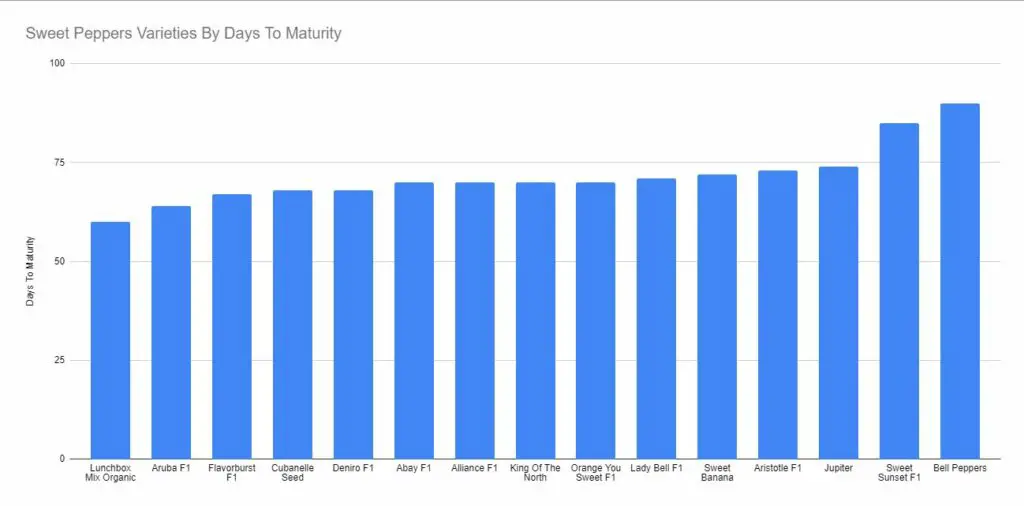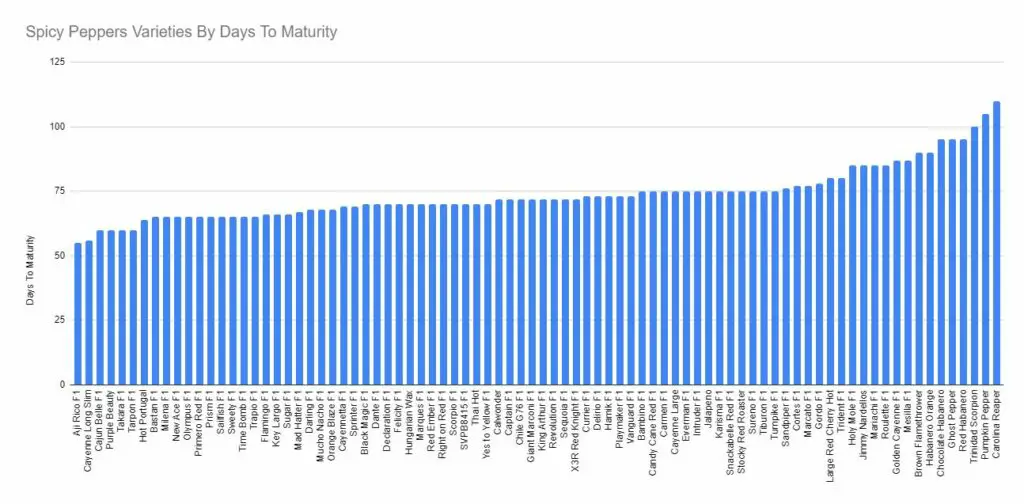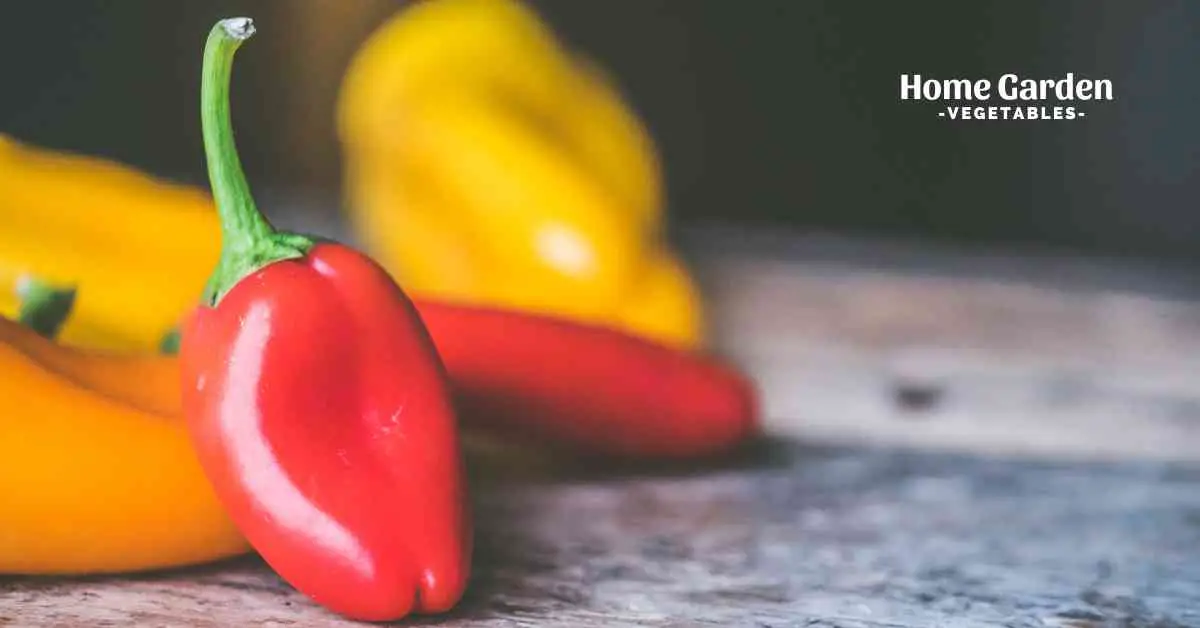It takes about 60 to 90 days to grow peppers from seed. Peppers are a warm-season crop, so they must be started indoors in late winter or early spring. Sow the seeds in sterile, well-drained potting mix, and keep them warm (about 70 degrees Fahrenheit).
Peppers can take anywhere from two to four weeks to germinate, depending on the variety. Once they’ve grown, it’ll take another four to six weeks to mature. So, if you’re patient, you could be harvesting peppers in as little as two months.
Reader Poll: What online courses would interest you?
Once they germinate, move the seedlings to a sunny spot. When the weather warms in late spring, harden off the seedlings and transplant them to the garden. Give them room to grow, as peppers need good air circulation to prevent disease. With proper care, you’ll be harvesting fresh peppers in no time! I have been through nearly 100 seed packets to compile the following mega list. However, if I have missed a variety please comment below and I will add it in.
How Many Different Types Of Peppers Are There?
Before we continue it’s best to point out that there are many different types of peppers. Peppers fall under the species capsicum. Here are some of the common ones you will find in grocery stores and markets.
- Bell Peppers also Known as Sweet peppers
- Spicy Peppers
How Long Do Peppers Take To Grow?
This is a very much “it depends” answer but given ideal growing conditions peppers can take anywhere from x days to x to fully grow and ripen.
Subscribe to our newsletter!
List Of Sweet Peppers And Time To Maturity
| Variety | Days To Maturity |
| Bell Peppers | 90 |
| Abay F1 | 70 |
| Alliance F1 | 70 |
| Aristotle F1 | 73 |
| Aruba F1 | 64 |
| Cubanelle Seed | 68 |
| Deniro F1 | 68 |
| Flavorburst F1 | 67 |
| Jupiter | 74 |
| King Of The North | 70 |
| Lady Bell F1 | 71 |
| Lunchbox Mix Organic | 60 |
| Orange You Sweet F1 | 70 |
| Sweet Banana | 72 |
| Sweet Sunset F1 | 85 |
The fastest-growing varieties of sweet / bell pepper are Lunchbox Mix Organic, Aruba F1 and Flavorburst F1.
List of Spicy Peppers And Time To Maturity
| Variety | Days To Mature |
| Aji Rico F1 | 55 |
| Bambino F1 | 75 |
| Bastan F1 | 65 |
| Black Magic F1 | 70 |
| Brown Flamethrower | 90 |
| Cajun Belle F1 | 60 |
| Calwonder | 72 |
| Candy Cane Red F1 | 75 |
| Captain F1 | 72 |
| Carmen F1 | 75 |
| Carolina Reaper | 110 |
| Cayenne Large | 75 |
| Cayenne Long Slim | 56 |
| Cayennetta F1 | 69 |
| Chile G76 F1 | 72 |
| Chocolate Habanero | 95 |
| Cortes F1 | 77 |
| Currier F1 | 73 |
| Dante F1 | 70 |
| Darling F1 | 68 |
| Declaration F1 | 70 |
| Delirio F1 | 73 |
| Everman F1 | 75 |
| Felicity F1 | 70 |
| Flamingo F1 | 66 |
| Ghost Pepper | 95 |
| Giant Marconi F1 | 72 |
| Golden Cayenne F1 | 87 |
| Gordo F1 | 78 |
| Habanero Orange | 90 |
| Hamik F1 | 73 |
| Holy Mole F1 | 85 |
| Hot Portugal | 64 |
| Hungarian Wax | 70 |
| Intruder F1 | 75 |
| Jalapeno | 75 |
| Jimmy Nardellos | 85 |
| Karisma F1 | 75 |
| Key Largo F1 | 66 |
| King Arthur F1 | 72 |
| Large Red Cherry Hot | 80 |
| Mad Hatter F1 | 67 |
| Marcato F1 | 77 |
| Mariachi F1 | 85 |
| Marques F1 | 70 |
| Mesilla F1 | 87 |
| Milena F1 | 65 |
| Mucho Nacho F1 | 68 |
| New Ace F1 | 65 |
| Olympus F1 | 65 |
| Orange Blaze F1 | 68 |
| Playmaker F1 | 73 |
| Primero Red F1 | 65 |
| Prism F1 | 65 |
| Pumpkin Pepper | 105 |
| Purple Beauty | 60 |
| Red Ember F1 | 70 |
| Red Habanero | 95 |
| Revolution F1 | 72 |
| Right on Red F1 | 70 |
| Roulette F1 | 85 |
| Sailfish F1 | 65 |
| Sandpiper F1 | 76 |
| Scorpio F1 | 70 |
| Sequoia F1 | 72 |
| Snackabelle Red F1 | 75 |
| Sprinter F1 | 69 |
| Stocky Red Roaster | 75 |
| Sugar F1 | 66 |
| Sureno F1 | 75 |
| SVPB8415 F1 | 70 |
| Sweety F1 | 65 |
| Takara F1 | 60 |
| Tarpon F1 | 60 |
| Thai Hot | 70 |
| Tiburon F1 | 75 |
| Time Bomb F1 | 65 |
| Trapio F1 | 65 |
| Trident F1 | 80 |
| Trinidad Scorpion | 100 |
| Turnpike F1 | 75 |
| Vanguard F1 | 73 |
| X3R Red Knight F1 | 72 |
| Yes to Yellow F1 | 70 |
Here are charts (everyone loves a chart).


Conclusion
To conclude, it takes around six to eight weeks for peppers to grow from seed. However, this timeframe can differ depending on the type of pepper, the growing conditions, and the care the plant receives.
Once the peppers have germinated and begun to grow, they will need to be transplanted into individual pots or raised beds. From there, the peppers need to be regularly watered and fertilized to ensure optimal growth. With proper care, peppers can be harvested within two to three months after transplanting.
How many peppers will one seed produce?
This is a difficult question to answer, as it depends on several factors, including the type of pepper, the growing conditions, and the level of care given to the plant. In general, however, one seed will produce one pepper plant with a few peppers.
How long does it take bell peppers to mature from seed?
Bell peppers typically take around 60-90 days to mature from seed. However, this can vary somewhat depending on the variety of pepper and the growing conditions.
For example, the peppers may mature slightly faster if the weather is hot. Conversely, the peppers may take a bit longer to develop if the weather is cooler than average. In general, you can expect bell peppers to be ready to harvest in about two months when grown from seed.
Are peppers easy to grow from seed?
Peppers can be finicky plants, and they may only sometimes germinate well. The conditions in which they are grown also play a role – if the weather is too hot or too cold, peppers may not thrive.
However, peppers can quickly grow from seed with proper care and attention. Start them indoors in pots, then transplant them outside once the weather warms up. Keep an eye on the temperature, and make sure to water them regularly. You can grow healthy and delicious peppers from seed with little effort.
How often should I water pepper seeds?
You should water pepper seeds about once a week or when the soil feels dry. Be careful not to overwater, as this can cause the seeds to rot. Aim to wet the soil without getting water on the leaves, which can cause fungal growth.
When should I start peppers indoors?
If you want to start peppers indoors, the best time to do so is about 6-8 weeks before the last frost date in your area. Peppers need warm temperatures to thrive, so you’ll need to provide them with a warm, sunny spot in your home.
If you can’t provide them with enough natural light, you’ll need to supplement them with artificial lighting. Keep the soil moist but not soggy, and fertilize every few weeks to keep the plants healthy. Once the peppers start to flower, you can pinch off the tips of the branches to encourage more fruit production.
Do peppers need full sun?
Most peppers need full sun to produce the best yields. Peppers are warm-weather crops and do not do well in cool or cold temperatures. They need at least six hours of direct sunlight daily to produce a good harvest.
If you live in an area with cool summers, you may need to provide additional artificial heat to keep your peppers warm enough to produce a good crop.
What fertilizer do peppers like?
Peppers are one of those vegetables that seem to be a bit fussy regarding fertilizer. They like fertilizer with a slightly higher nitrogen content than other vegetables.
This is because nitrogen is responsible for vegetative growth, and peppers are very vegetative plants. They also like a slightly acidic fertilizer, around 6.5 on the pH scale. This is because peppers are sensitive to pH levels, and a somewhat acidic fertilizer will help them thrive.
When should I start pepper seeds?
The best time to start pepper seeds is in the spring, about 6-8 weeks before the last frost date. Peppers are a warm-weather crop, so they will only do well if started early enough. If you start them too late, they may need more time to mature before the frost hits.
Which p

